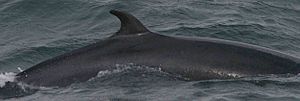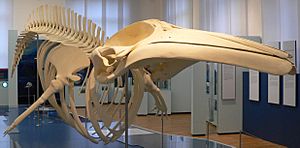Minke whale facts for kids
Quick facts for kids Minke whale |
|
|---|---|
 |
|
| A surfacing minke whale, Skjálfandi, Iceland | |
 |
|
| Size compared to an average human | |
| Conservation status | |
| Scientific classification | |
| Kingdom: | |
| Phylum: | |
| Class: | |
| Order: | |
| Family: | |
| Genus: | |
| Species: |
B. acutorostrata
B. bonaerensis |
The Minke whale is the smallest of the baleen whales that lives in many places in the world. It is the smallest rorqual whale (the large baleen whales). A large one is about 30 feet long and weighs 10 tons. They are black or gray with white on their belly and a white "armband" across their flippers. It is the only baleen whale that is still hunted for money. The Minke whale can swim quite fast.
There are two types of Minke whale. They are:
- Common minke whale or northern minke whale (Balaenoptera acutorostrata), and
- Antarctic minke whale or southern minke whale (Balaenoptera bonaerensis)
Contents
Description

The minke whales are the second smallest baleen whale. Only the pygmy right whale is smaller. Males measure an average of 6.9 m (23 ft) and females 7.4 m (24 ft) in length. Both sexes typically weigh 4 - 5 t (3.9–4.9 long tons; 4.4–5.5 short tons) as adults. The maximum weight may be as much as 14 t (14 long tons; 15 short tons). They become adults after 6 to 8 years.
The minke whale is a black/gray/purple color. Common minke whales (Northern Hemisphere variety) have a white band on each flipper. The body is usually black or dark-gray above and white underneath. Most of the back, including dorsal fin and blowholes, appears at once when the whale comes to the surface to breathe.
Minke whales usually live for 30–50 years. In some cases they may live for up to 60 years.
The gestation time for minke whales is 10 months. Calves measure 2.4 to 2.8 m (7.9 to 9.2 ft) at birth. The newborns nurse for five to possibly 10 months. Breeding is mostly done during the summer months. Calving is thought to happen every two years.
The whale breathes three to five times at short intervals before 'deep-diving' for two to 20 minutes. Deep dives are preceded by a pronounced arching of the back. The maximum swimming speed of minkes has been estimated at 38 km/h (24 mph).
Migration
Both species undertake seasonal migration routes to the poles during spring and towards the tropics during fall and winter. Difference between the timing of the seasons may prevent the two closely related species from mixing. A long-term photo identification study on the British Columbian and Washington coasts showed that some individuals travel as far as 424 km north in the spring, and 398 km south to warmer waters in the autumn. Many specifics about migration in this species still remain unclear.
Reproduction
The gestation period for minke whales is 10 months, and calves measure 2.4 to 2.8 m (7.9 to 9.2 ft) at birth. The newborns nurse for five to 10 months. Breeding peaks during the summer months. Calving is thought to occur every two years.
The timing of conception and birth varies between region.
In the North Atlantic conception takes place from December to May with a peak month of February with birth taking place from October to March with a peak in December. In the North Pacific off Japan there appears to be two phases of conception, the majority of which occurs from February to March but also from August to September, with births occurring from December to January and June to July. In the Yellow Sea stock these two phases have not been noted with conception occurring from July to September and birth peaking from May to June.
In the Southern Hemisphere conception takes place from June to December with a peak in August and September. Peak birth time occurs from July to August.
Predation
Killer whale predation on minke whales has been well documented. A study in 1975 found that in 49 killer whale stomachs, 84% had consumed minke whale. Minke whale carcasses investigated after attacks show that killer whales have an affinity for minke tongues and lower jaw. The anti-predatory mechanism of the minke whale is strictly a flight response, as when this fails no physical retaliation is observed. Chases most commonly lead into open ocean, although there have been records of minke whales inadvertently swimming into confined, shallow waters. There have been two recorded instances of minke whales ending high speed chases by hiding under a ship's hull, however, both instances were unsuccessful.
Diet
North Atlantic
Minke whales in the north Atlantic are observed to take a variety of food items. Before 1993, minke whales in the north Barents Sea fed predominantly on capelin until stocks collapsed and the whales switched to krill as their primary prey type. The minke whale population in the Norwegian Sea primarily feeds on adult herring while krill, capelin, and sand eels are also recorded prey types. In Scotland, sand eels are the most commonly observed prey species, followed by herring and sprat. Seasonal variations are observed off of Finnmark, with krill the most popular prey type in the summer and cod in the autumn. Stable isotope analysis from 2003 shows minke whales in the north Atlantic also feed on prey from lower trophic levels as well.
North Pacific
Two stocks of minke whale are observed in the north pacific: the "J stock" (Sea of Japan - Yellow Sea - East China sea) and the "O stock" (Okhotsk sea - west Pacific). Seasonal variations in diet exist. J stock whales' primary prey type is Japanese anchovy during May and June, pacific saury in July and August, and krill in September. O stock whales primarily feed on krill in July and August. Most minke whales observed in 2002 (90.4%) fed solely on one prey species.
Antarctic
Antarctic minke whales are diurnal feeders. This minke whale population mainly feeds on Antarctic krill in offshore areas and ice krill in coastal areas on the continental shelf such as the Ross sea and Prydz bay. The population has been recorded to forage on ten known species: five fish (Antarctic silverfish, antarctic jonasfish, Antarctic lanternfish, Chionodraco, and Notothenia), four euphausiids (Antarctic krill, ice krill, Euphausia frigida, Thysanoessa macrura), and one amphipod (Themisto gaudichaudii).
Images for kids
See also
 In Spanish: Rorcual Minke para niños
In Spanish: Rorcual Minke para niños






